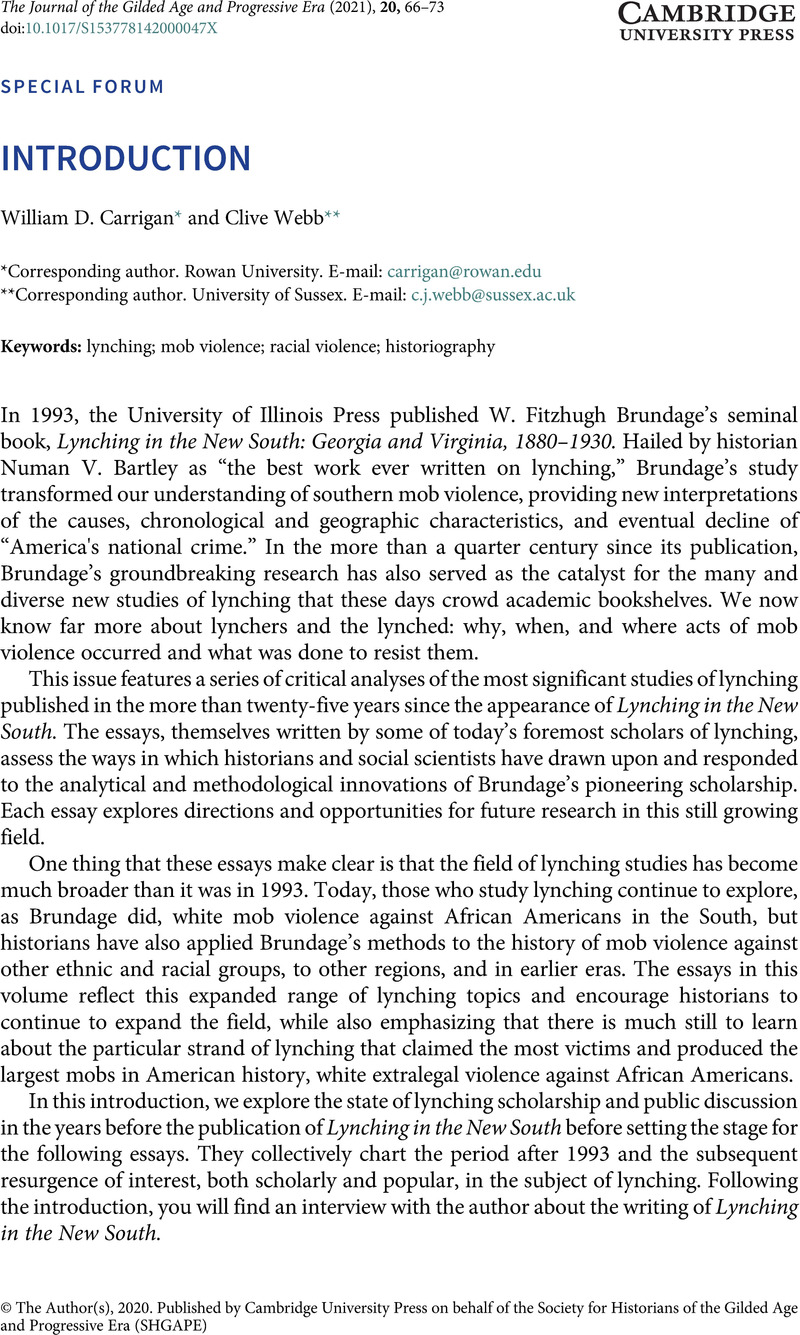No CrossRef data available.
Published online by Cambridge University Press: 09 December 2020

1 Waldrep, Christopher, The Many Faces of Judge Lynch: Extralegal Violence and Punishment in America (New York: Palgrave, 2002).CrossRefGoogle Scholar
2 Wells, Ida B., Southern Horrors: Lynch Law in All Its Phases (New York: The New York Age Print, 1892).Google Scholar
3 Du Bois, W. E. B., The Souls of Black Folk, Oxford World Classics ed. (New York: Oxford University Press, 2007), 77, 89.Google Scholar
4 Cutler, James Elbert, Lynch-Law: An Investigation into the History of Lynching in the United States (New York: Longmans, Green, and Company, 1905).Google Scholar
5 Cutler, James Elbert, “The Practice of Lynching in the United States,” South Atlantic Quarterly, 6 (1907): 125–34.Google Scholar
6 Cutler, , Lynch-Law, 1.Google Scholar
7 Chadbourn, J. H., Lynching and the Law (Chapel Hill: University of North Carolina Press, 1933)Google Scholar; Raper, Arthur F., The Tragedy of Lynching (Chapel Hill: University of North Carolina Press, 1933)Google Scholar; Dollard, John, Caste and Class in a Southern Town (New Haven, CT: Yale University Press, 1937).Google Scholar
8 Wyatt-Brown, Bertram, Southern Honor: Ethics and Behavior in the Old South (New York: Oxford University Press, 1982), 402.Google Scholar
9 Williamson, Joel, The Crucible of Race: Black-White Relations in the American South since Emancipation (New York: Oxford University Press, 1984).Google Scholar
10 Hall, Jacquelyn Dowd, Revolt Against Chivalry: Jessie Daniel Ames and the Women’s Campaign Against Lynching (Columbia: New York University Press, 1979)Google Scholar; Zangrando, Robert L., The NAACP Crusade Against Lynching, 1909–1950 (Philadelphia: Temple University Press, 1980).Google Scholar
11 Wright, George C., Racial Violence in Kentucky, 1865–1940: Lynchings, Mob Rule, and “Legal Lynchings” (Baton Rouge: Louisiana State University Press, 1990)Google Scholar. Local historians and graduate students had done some of this work, often resulting in regional publications or master’s theses at state universities. This work, however, found a limited audience from the historical profession that did not yet consider lynching a topic of importance compared to the more familiar subjects within political, military, and diplomatic history. See, for just two examples, Fred Lockley’s pamphlet, Vigilante Days at Virginia City (privately printed, 1924) and Warren Franklin Webb, “A History of Lynching in California since 1875” (MA thesis, University of California, 1935).
12 Wright, , Racial Violence in Kentucky, 5.Google Scholar
13 Fitzhugh Brundage, W., Lynching in the New South: Georgia and Virginia (Urbana: University of Illinois Press, 1993), 159.Google Scholar
14 Ingalls, Robert P., review of Lynching in the New South, American Historical Review, 99:5 (Dec. 1994): 1758–59.Google Scholar
15 Pullen, Ann Ellis, review of Lynching in the New South, Journal of Southern History 61:2 (May 1995): 401.CrossRefGoogle Scholar
16 Dinnerstein, Leonard, review of Lynching in the New South, Florida Historical Quarterly 73:2 (Oct. 1994): 251–52Google Scholar; Dinnerstein, Leonard, The Leo Frank Case (New York: Columbia University Press, 1968).Google Scholar
17 Godshalk, David F., “A New Look at Mob Violence,” Callaloo 17:4 (Autumn, 1994): 1272–73.CrossRefGoogle Scholar
18 Griffin, Larry J., review of Lynching in the New South, Contemporary Sociology 23:6 (Nov. 1994): 814–15.CrossRefGoogle Scholar
19 Allen, James, ed., Without Sanctuary: Lynching Photography in America (Santa Fe, NM: Twin Palm Publishers, 2000)Google Scholar. Allen’s collection includes essays by academics and scholars did help with the research on the images in the volume, but Allen himself was not an academic and did not publish through a university press.